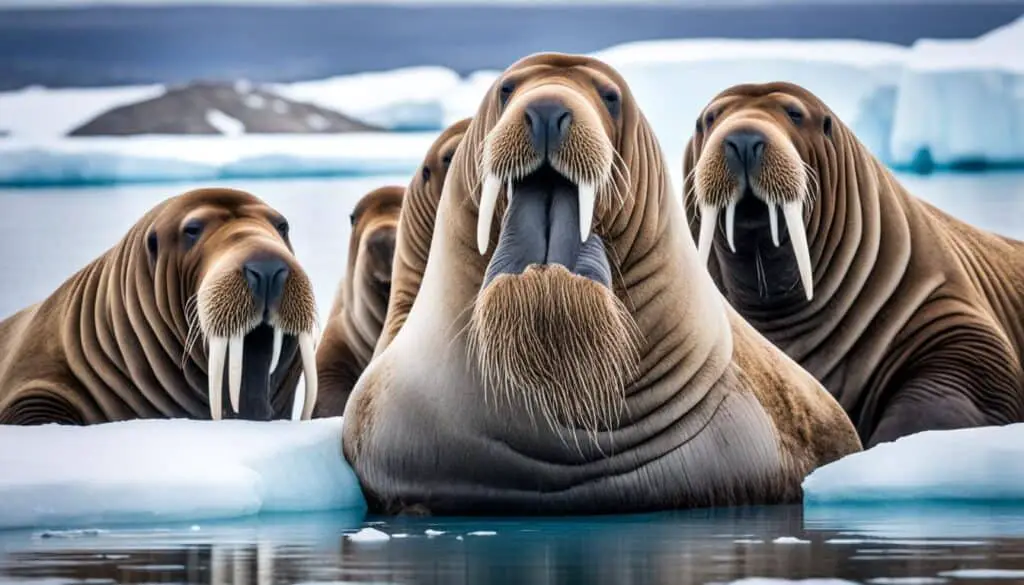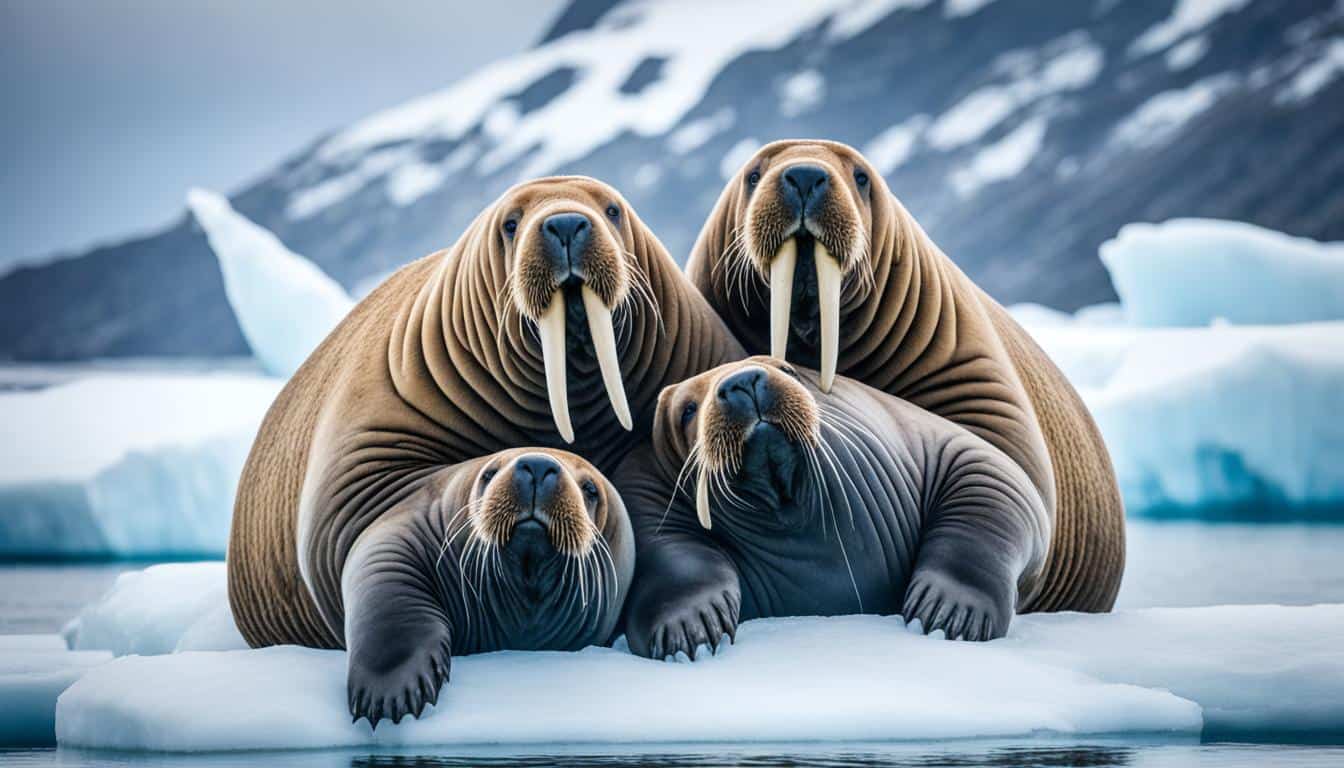Walruses are amazing creatures that live in the cold Arctic. They have special ways to stay alive in freezing temperatures. Let’s look at how they adapt to the cold.
They have thick skin and blubber to keep warm. Their bodies are built for the cold. They also have special behaviors to stay warm.
These adaptations help them survive in the harsh Arctic. They play a big role in the Arctic ecosystem. Let’s dive deeper into their survival strategies.
Understanding Walrus Adaptations to Cold
Adaptation is key for species to survive in various environments. For walruses, living in icy Arctic waters shows their amazing ability to adapt. They have both physical and behavioral traits that help them handle the cold.
The Concept of Adaptation
An adaptation is a trait that helps an organism survive in its home. Walruses have many walrus adaptations to cold. These include physical changes and behaviors that keep them warm.
Physical vs. Behavioral Adaptations
Walrus adaptations fall into two types: physical and behavioral. Physical traits include:
- Thick blubber layer for insulation
- Specialized skin structure that helps retain heat
- Large body size, which minimizes heat loss
Behavioral adaptations are actions walruses take to stay alive:
- Huddling together in groups to share warmth
- Specific diving and hunting strategies that minimize exposure to the cold
- Seeking sheltered areas in the ice to protect against wind and cold
| Adaptation Type | Examples |
|---|---|
| Physical Adaptations | Thick blubber, large size, specialized skin |
| Behavioral Adaptations | Grouping for warmth, strategic diving |
Thanks to these adaptations, walruses can live in the cold. They show how resilient and resourceful they are in harsh conditions.
How do walruses adapt to cold environments?
Walruses have amazing ways to stay warm in the cold. They use thermoregulation to keep their body temperature stable, even in icy waters. Their body structure helps them keep vital processes going in extreme cold.
Thermoregulation Techniques
Walruses keep warm by constricting their blood vessels. This means they reduce blood flow to their skin, saving heat. They also have a thick layer of blubber, up to 10 cm (3.9 inches) thick, which insulates them and stores energy. These features are key to their survival in the cold.
Body Structure and Insulation
The walrus’s body is made for the Arctic. It’s streamlined for moving through icy waters, which helps keep them warm. The blubber layer is vital for insulation and supports important metabolic functions. Despite changing temperatures, walruses keep their metabolism stable, showing how well they adapt to their cold home.
| Body Feature | Function |
|---|---|
| Blubber Thickness | Insulation & Energy Reserve |
| Circulatory Adjustments | Heat Conservation |
| Streamlined Body Shape | Efficient Movement in Water |
Physiological Adaptations of Walruses to Cold Climates
Walruses have amazing ways to stay alive in freezing places. They have thick blubber and special circulatory changes. These help them live in the harsh Arctic.
Blubber: The Ultimate Insulator
The blubber of a walrus is key to its survival. It acts as a thick layer of blubber insulation. This keeps them warm in cold water and air. It makes up about one-third of their body weight.
This fat layer keeps them warm and also stores energy. This is important when food is hard to find.
Circulatory Adjustments During Cold Exposure
When it gets very cold, walruses make big changes to stay warm. They make their blood vessels smaller. This cuts down blood flow to their skin and limbs.
This helps save heat and keep their core warm. When they dive, their heart rate goes down. This makes them use less oxygen. It helps them get enough oxygen for their organs in the cold water.
Walrus Behavior in Cold Climates
Walruses live in cold climates and have adapted well to the Arctic. They work together and hunt in groups to survive. This helps them stay warm and find food in tough conditions.
Social Interactions and Heat Retention
Walruses stay warm by huddling together on ice or land. This keeps them from losing heat. It’s important for keeping warm in the cold.
Being together also helps them communicate and hunt better. They work as a team to find food in the Arctic, where it’s hard to find.
Diving and Hunting Strategies
Walruses are great at hunting in cold water. They can dive over 90 meters deep and hold their breath for up to 10 minutes. They mainly eat clams and other sea creatures from the seafloor.
Their thick blubber keeps them warm and gives them energy for diving. This shows how their social and hunting skills help them survive in the cold.
| Behavior Type | Details |
|---|---|
| Social Interactions | Huddling together for heat retention and support during hunting efforts. |
| Diving | Dive depth: Up to 90 meters; Breath-hold duration: Up to 10 minutes. |
| Hunting Strategies | Focus on benthic prey in shallow waters, utilizing community support. |
Walrus Habitat in Arctic Regions
The Arctic is home to diverse ecosystems where walruses live. These marine mammals love the cold and can be found near ice floes. These places are important for resting and breeding, helping to keep their numbers healthy.
Walruses live where they can find lots of food. They eat things like clams and mollusks found in the cold water. Having enough food is key for them, especially when they have babies.
Ice is a big part of their home. They use it to give birth and care for their young, keeping them safe from predators. Walruses can even survive in very cold temperatures, like -35°C (-31°F). This shows how well they’ve adapted to the Arctic.
Learning about where walruses live shows how life in the Arctic is balanced. It’s important to protect their home to help them survive in a changing world.
Conclusion: The Remarkable Resilience of Walruses to Cold
Walruses show amazing ways to live in freezing places. They have special traits that help them survive. For example, their thick blubber keeps them warm and also stores energy when food is scarce.
This blubber is crucial for keeping their body temperature stable in extreme cold. It’s a key part of how they stay warm.
Walruses also show how well they can handle the cold through their social habits. They live in big groups to stay warm and protect each other from harsh winds. This social behavior is a big part of their survival.
When they go hunting, walruses use their oxygen wisely, letting them stay underwater longer. These skills show how they can not just survive but also do well in the Arctic.

Future Considerations for Walrus Adaptations in a Changing Climate
As we watch the Arctic’s walruses, we see how climate change affects their survival. Global temperatures are going up, bringing new Arctic adaptation challenges. These challenges threaten the balance of their home.
One big issue is losing their important resting and breeding spots. These spots are key to their life cycle. Climate change also changes where their food is, making it hard for walruses to find what they need.
Understanding how walruses adapt to climate change is crucial for their future. This situation shows why we need ongoing research. We must watch how walruses adapt or if their numbers will go down.
Scientists and conservationists must think about these changes when making plans to help these amazing animals. By understanding the effects of walrus survival in warming Arctic ecosystems, we can support better conservation efforts. These efforts should tackle the special challenges walruses face in a fast-changing world.
FAQ
How do walruses maintain their body temperature in cold environments?
Walruses keep warm through several methods. They have a thick layer of blubber that insulates and stores energy. They also make their blood vessels smaller to lose less heat, keeping warm in the cold.
What are the main physical adaptations of walruses to cold climates?
Walruses have a thick blubber layer, up to 10 cm thick, for insulation. Their skin helps reduce heat loss while keeping them warm in extreme cold.
Can walruses survive in extremely low water temperatures?
Yes, walruses can be found in water as cold as -35°C (-31°F). Their special adaptations let them live in the harsh Arctic and sub-Arctic.
What are the behavioral strategies walruses use to survive in cold climates?
Walruses stay warm by huddling together. They also hunt together to find food more easily in the cold Arctic waters.
How does a walrus’s blubber benefit its survival in cold environments?
Blubber keeps heat in and is a food reserve, crucial in harsh winters when food is scarce. It makes up about one-third of a walrus’s body.
What impact does climate change have on walrus habitats?
Climate change threatens walrus habitats by changing where they find food and where they rest and breed. It’s important to understand these changes for conservation.
What depths can walruses dive to when hunting for food?
Walruses dive over 90 meters (295 feet) deep to find food on the ocean floor. They can hold their breath for up to 10 minutes during these dives.
How do walruses adapt their circulatory systems in cold water?
In cold water, walruses make their blood vessels smaller to keep heat in. Their heart beats slower during dives to use oxygen efficiently for their organs.







